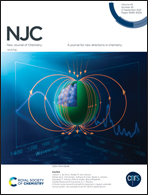Visible light-driven photocatalytic degradation of organic pollutants via carbon quantum dots/TiO2†
Abstract
Using olive leaves as the carbon source, carbon quantum dots (CQDs) with up-conversion luminescence were prepared via a reflux method. Through a hydrothermal treatment, CQDs were loaded on the surface of TiO2 to form a CQDs/TiO2 composite that exhibited photocatalytic properties. The morphology, size and composition of the as-prepared composite were characterized using XRD, SEM, TEM and XPS. Excited at the wavelength range from 560 nm to 740 nm, CQDs exhibited a significant multi-photon-based up-conversion luminescence property. This property of CQDs endowed CQDs/TiO2 composites with great photocatalytic efficiency. The performance of CQDs/TiO2 composites was tested in the degradation of tetracycline (TC) and rhodamine B (RhB). Irradiated under visible light for 10 min and 70 min, the degradation rates of 5% CQDs/TiO2 reached 81% and 92% for TC and RhB, respectively. Photocurrent and PL tests indicated that the loading of CQDs significantly improved the separation efficiency of TiO2-photogenerated charge carriers. Taking advantage of the up-conversion luminescence property of CQDs, the harvesting efficiency of visible light by CQDs/TiO2 composites was greatly enhanced.



 Please wait while we load your content...
Please wait while we load your content...